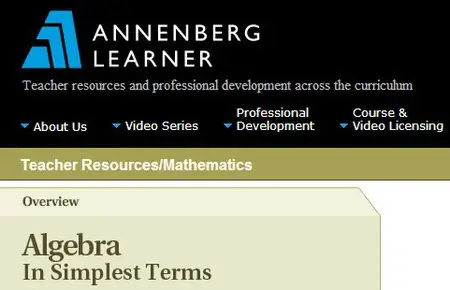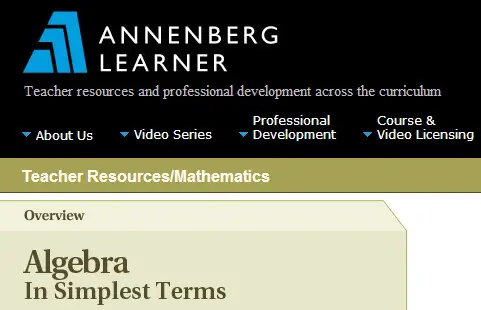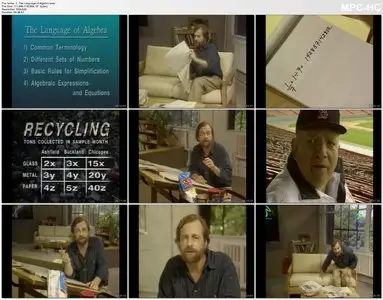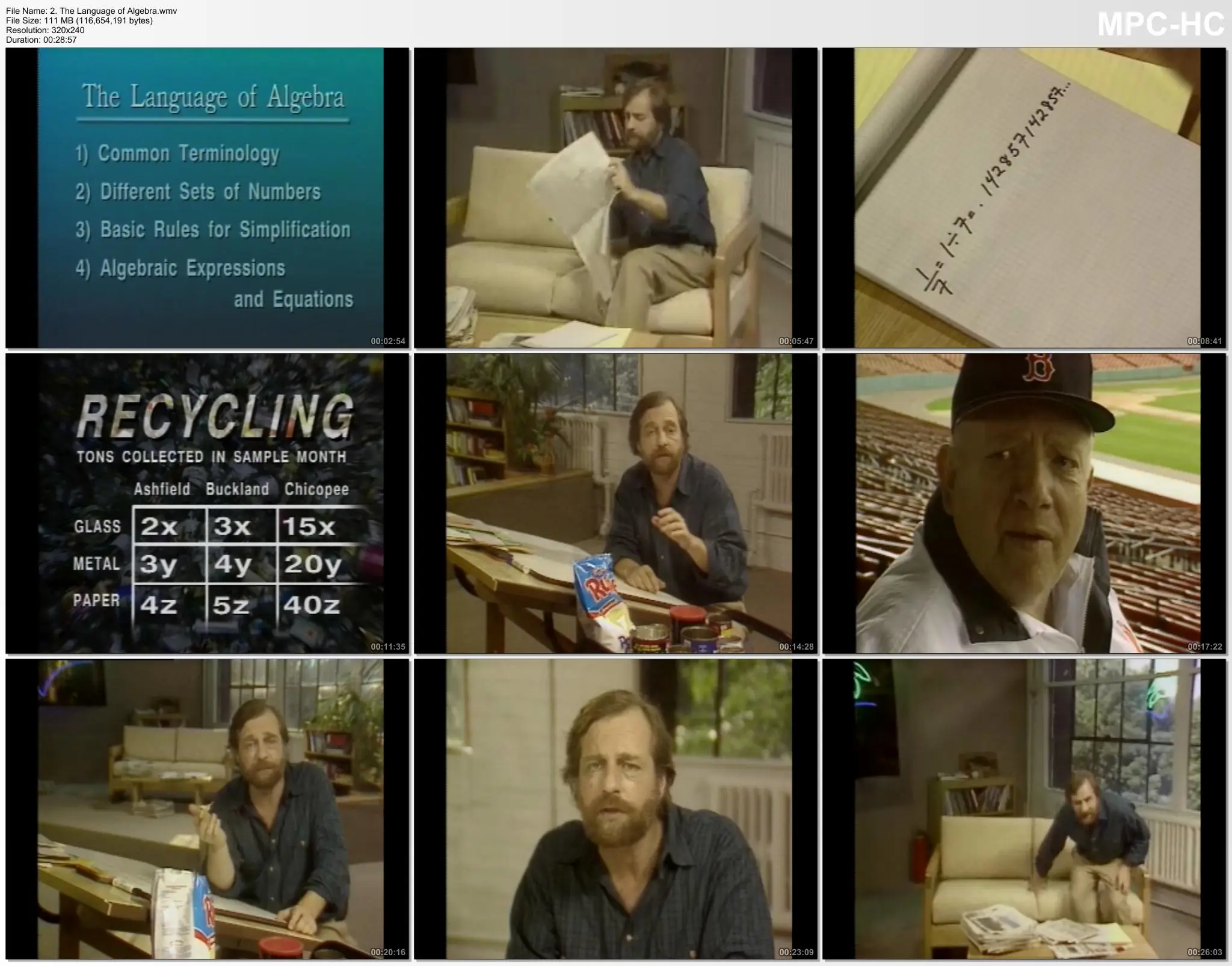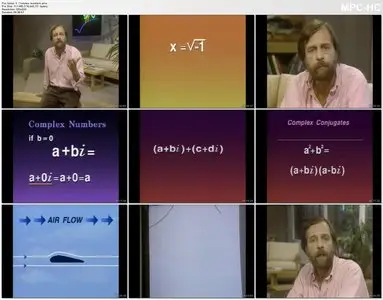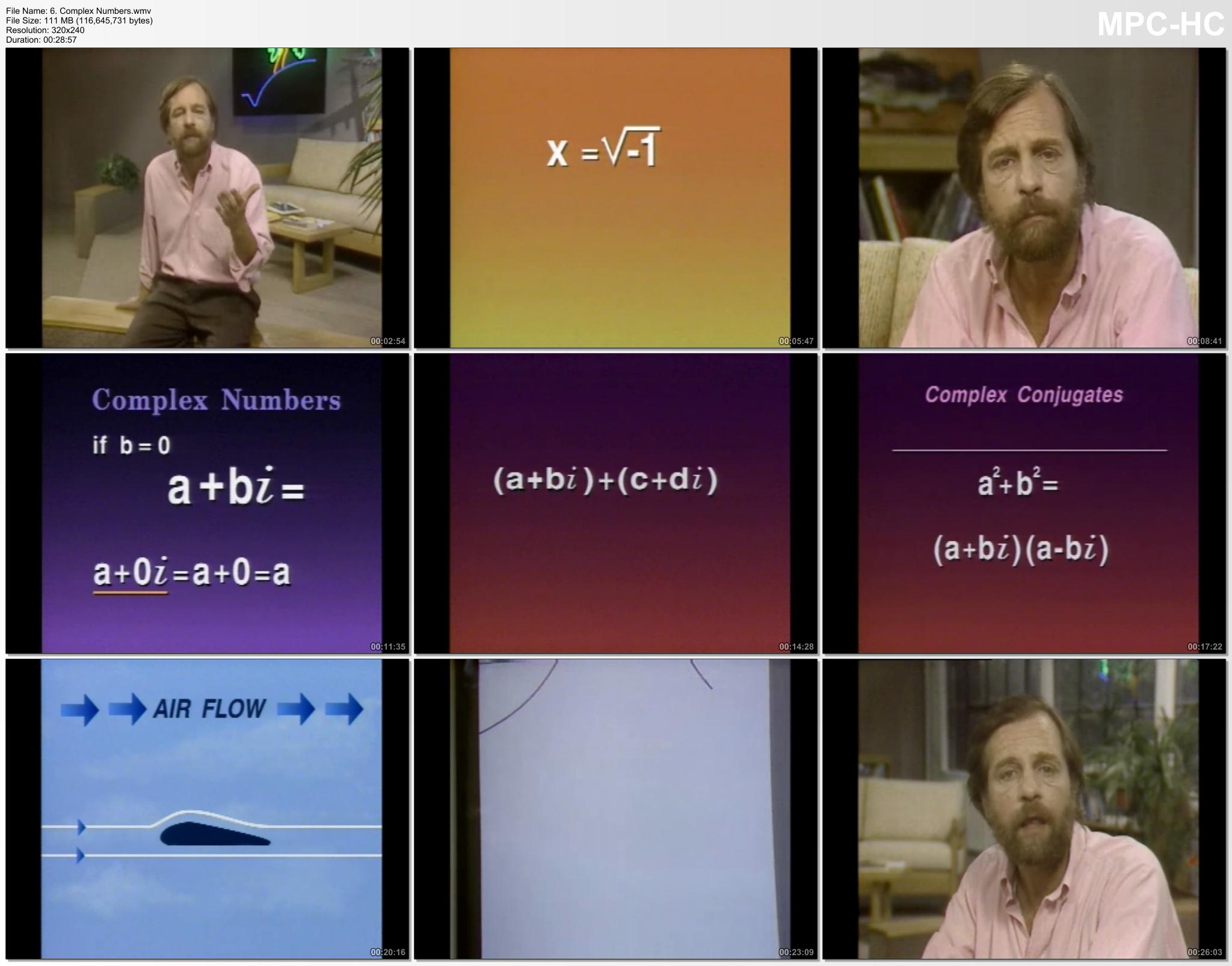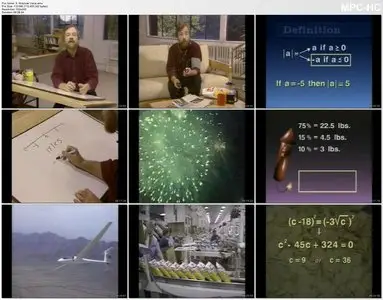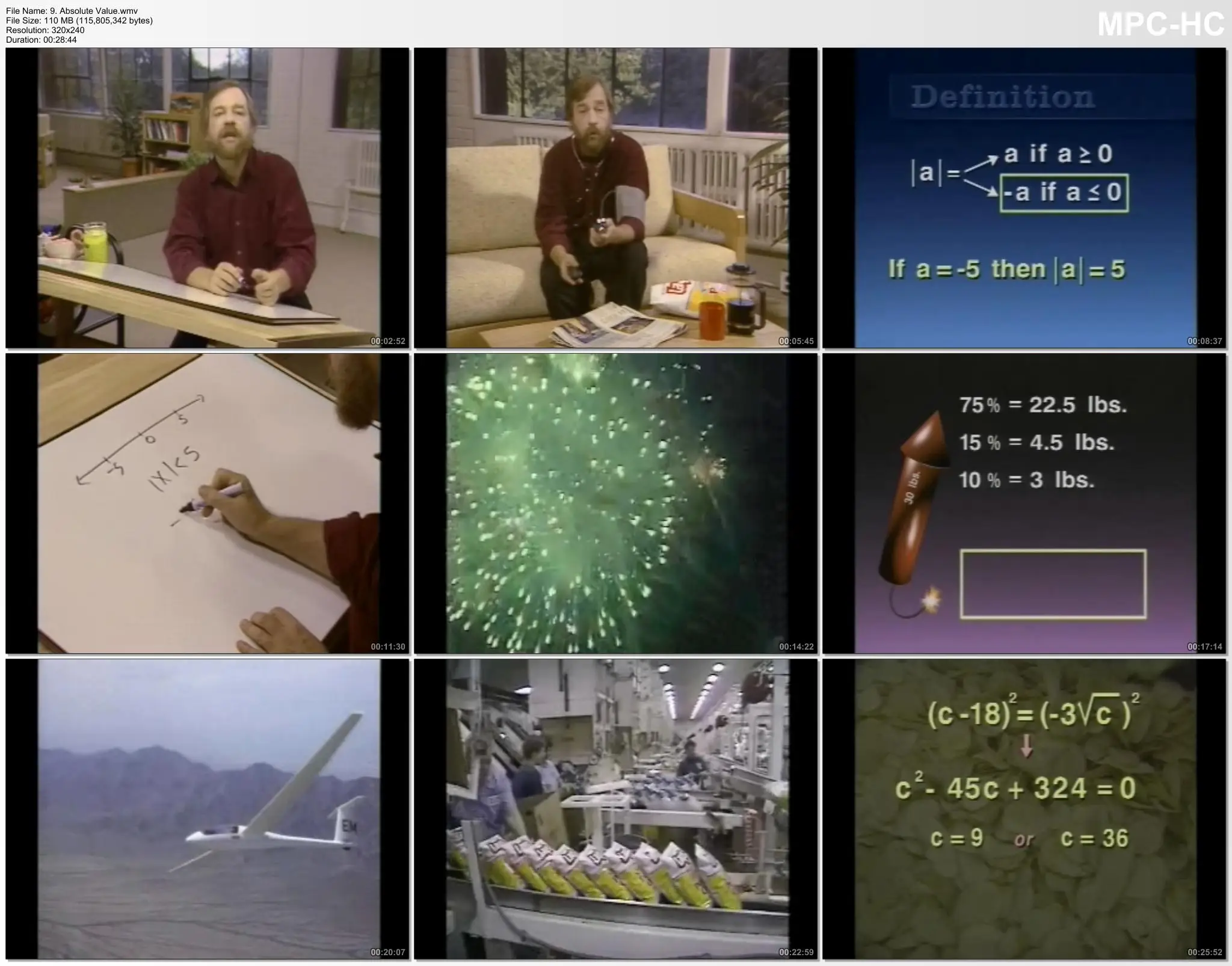Learner - Algebra - In Simplest Terms
DVD-Rip | WMV @ 300 Kbit/s | 320x240 | WMA Stereo @ 128 Kbit/s 44 KHz | 13 Hours | 2.81 GB
Genre: Mathematics, Algebra | Language: English
DVD-Rip | WMV @ 300 Kbit/s | 320x240 | WMA Stereo @ 128 Kbit/s 44 KHz | 13 Hours | 2.81 GB
Genre: Mathematics, Algebra | Language: English
A video instructional series on algebra for college and high school classrooms and adult learners; 26 half-hour video programs! In this series, host Sol Garfunkel explains how algebra is used for solving real-world problems and clearly explains concepts that may baffle many students. Graphic illustrations and on-location examples help students connect mathematics to daily life. The series also has applications in geometry and calculus instruction. Algebra is also valuable for teachers seeking to review the subject matter.
Technical details:
26 episodes of approx 30 mins length
Video format: WMV
Episode List:
1. Introduction
An introduction to the series, this program presents several mathematical themes and emphasizes why algebra is important in today’s world.
2. The Language of Algebra
This program provides a survey of basic mathematical terminology. Content includes properties of the real number system and the basic axioms and theorems of algebra. Specific terms covered include algebraic expression, variable, product, sum term, factors, common factors, like terms, simplify, equation, sets of numbers, and axioms. Definitions of these terms lay a foundation for working with the concepts.
3. Exponents and Radicals
This program explains the properties of exponents and radicals: their definitions, their rules, and their applications to positive numbers. The program shows how to use the Rules for Exponents to simplify expressions, demonstrating concepts through a discussion of the O-ring failure of the Challenger Space Shuttle.
4. Factoring Polynomials
This program defines polynomials and describes how the distributive property is used to multiply common monomial factors with the FOIL method. It covers factoring, the difference of two squares, trinomials as products of two binomials, the sum and difference of two cubes, and regrouping of terms.
5. Linear Equations
This is the first program in which equations are solved. It shows how solutions are obtained, what they mean, and how to check them using one unknown. Concepts are worked out in an application problem involving a modern sewage plant near Los Angeles, where a linear equation is set up and solved to determine how long to keep open an inlet pipe.
6. Complex Numbers
To the sets of numbers reviewed in previous lessons, this program adds complex numbers — their definition and their use in basic operations and quadratic equations. Students will learn how to combine like terms, apply the FOIL method, and rationalize the denominator for finding the product or quotient of two complex numbers.
7. Quadratic Equations
This program reviews the quadratic equation and covers standard form, factoring, checking the solution, the Zero Product Property, and the difference of two squares. Environmental and aviation examples provide realistic problems, and the method of Completing the Square is used to solve them.
8. Inequalities
This program teaches students the properties and solution of inequalities, linking positive and negative numbers to the direction of the inequality. The program presents three applications of inequalities: modeling problems of the U.S. Postal Service, finding the cheapest way to travel, and conducting market research in the pizza industry.
9. Absolute Value
In this program, the concept of absolute value is defined, enabling students to use it in equations and inequalities. One application example involves systolic blood pressure, using a formula incorporating absolute value to find a person’s “pressure difference from normal.” The recipe for making fireworks offers another example.
10. Linear Relations
This program looks at the linear relationship between two variables, expressed as a set of ordered pairs. Students are shown the use of linear equations to develop and provide information about two quantities, as well as the applications of these equations to the slope of a line.
11. Circle and Parabola
The circle and parabola are presented as two of the four conic sections explored in this series. The circle, its various measures when graphed on the coordinate plane (distance, radius, etc.), its related equations (e.g., center-radius form), and its relationships with other shapes are covered, as is the parabola with its various measures and characteristics (focus, directrix, vertex, etc.). An earthquake epicenter provides a real-life illustration.
12. Ellipse and Hyperbola
The ellipse and hyperbola, the other two conic sections examined in the series, are introduced. The program defines the two terms, distinguishing between them with different language, equations, and graphic representations. Architecture and surgery provide interesting application examples.
13. Functions
This program defines a function, discusses domain and range, and develops an equation from real situations. The cutting of pizza and encoding of secret messages provide subjects for the demonstration of functions and their usefulness.
14. Composition and Inverse Functions
Graphics are used to introduce composites and inverses of functions as applied to calculation of the Gross National Product. One-to-one functions and the horizontal line test are introduced, and more encoded messages and the hazards of “the bends” in scuba diving provide instructive applications of the functions discussed.
15. Variation
In this program, students are given examples of special functions in the form of direct variation and inverse variation, with a discussion of combined variation and the constant of proportionality. These are explored in relation to polynomials and assorted equations, with applications from chemistry, physics, astronomy, and the food industry.
16. Polynomial Functions
This program explains how to identify, graph, and determine all intercepts of a polynomial function. It covers the role of coefficients; real numbers; exponents; and linear, quadratic, and cubic functions. This program touches upon factors, x-intercepts, and zero values. These terms are demonstrated with the baking of pizza.
17. Rational Functions
A rational function is the quotient of two polynomial functions. The properties of these functions are investigated using cases in which each rational function is expressed in its simplified form. The relationship between numerator and denominator is clarified, and sign and other graphs are used to determine intercepts, symmetry, and asymptotes.
18. Exponential Functions
Students are taught the exponential function, as illustrated through formulas. The population of Massachusetts, the “learning curve,” bacterial growth, and radioactive decay demonstrate these functions and the concepts of exponential growth and decay.
19. Logarithmic Functions
This program covers the logarithmic relationship, the use of logarithmic properties, and the handling of a scientific calculator. How radioactive dating and the Richter scale depend on the properties of logarithms is explained. Many rules and tests from previous programs are also incorporated into the lesson.
20. Systems of Equations
The case of two linear equations in two unknowns is considered throughout this program. Elimination and substitution methods are used to find single solutions to systems of linear and nonlinear equations. Consistent, inconsistent, and dependent systems are also explored through examples from ship navigation and garment production.
21. Systems of Linear Inequalities
Elimination and substitution are used again to solve systems of linear inequalities. Linear programming is shown to solve problems in the Berlin airlift, production of butter and ice cream, school redistricting, and other situations while constraints, corner points, objective functions, the region of feasible solutions, and minimum and maximum values are also explored.
22. Arithmetic Sequences and Series
When the growth of a child is regular, it can be described by an arithmetic sequence. This program differentiates between arithmetic and nonarithmetic sequences as it presents the solutions to sequence- and series-related problems. Definitions include sequence, arithmetic sequence, arithmetic series, fixed number, and common difference.
23. Geometric Sequences and Series
This program provides examples of geometric sequences and series (f-stops on a camera and the bouncing of a ball), explaining the meaning of nonzero constant real number and common ratio. Finite and infinite geometric series and the sequence of partial sums are also defined in the discussion.
24. Mathematical Induction
Mathematical proofs applied to hypothetical statements shape this discussion on mathematical induction. This segment exhibits special cases, looks at the development of number patterns, relates the patterns to Pascal’s triangle and factorials, and elaborates the general form of the theorem.
25. Permutations and Combinations
How many variations in a license plate number or poker hand are possible? This program answers the question and shows students how it’s done. Techniques for counting the number of ways in which collections of objects can be arranged, ordered, and combined are demonstrated.
26. Probability
In this final program, students see how the various techniques of algebra that they have learned can be applied to the study of probability. The program shows that games of chance, health statistics, and product safety are areas in which decisions must be made according to our understanding of the odds. It also shows how the subject of probability has evolved to support such fields as genetics, social science, and medicine.
Website:
http://www.learner.org/resources/series66.html


